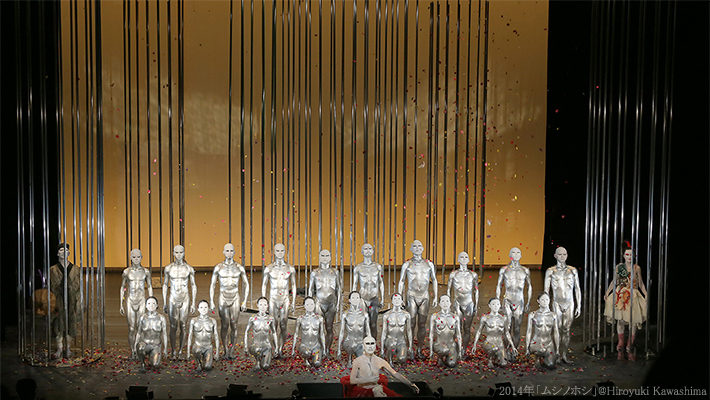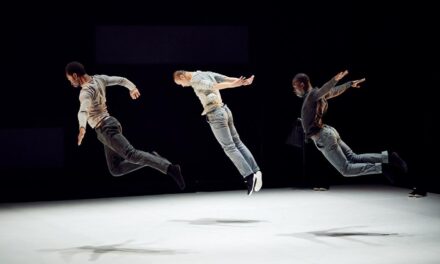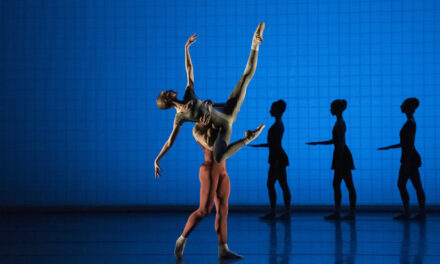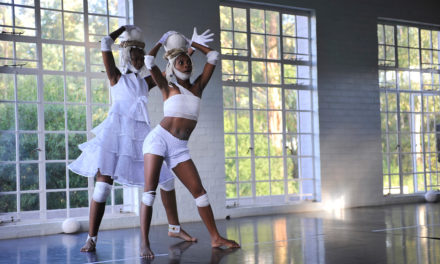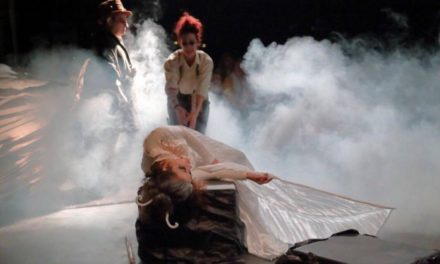Following a January press conference in which the New National Theatre, Tokyo, announced that Dairakudakan, one of the world’s leading butoh companies, would be staging two performances of Tsumi To Batsu (Crime And Punishment) in March, troupe founder Akaji Maro delivered a triumphant statement.
Having this unexpected yet fantastic opportunity (to work with the NNTT) feels revolutionary like we’ve finally conquered this national (state-run) citadel after so many years, – the 75-year-old artist said. – So I am very excited to seize our chance to create the best possible performance piece for the NNTT.
Maro and his cast of white-painted, barely clothed and shaven-headed dancers are sure to take the NNTT by storm when they move through their production in the seemingly unearthly ways of Japan’s most singular modern dance form with its grotesque poses and strange gestures.
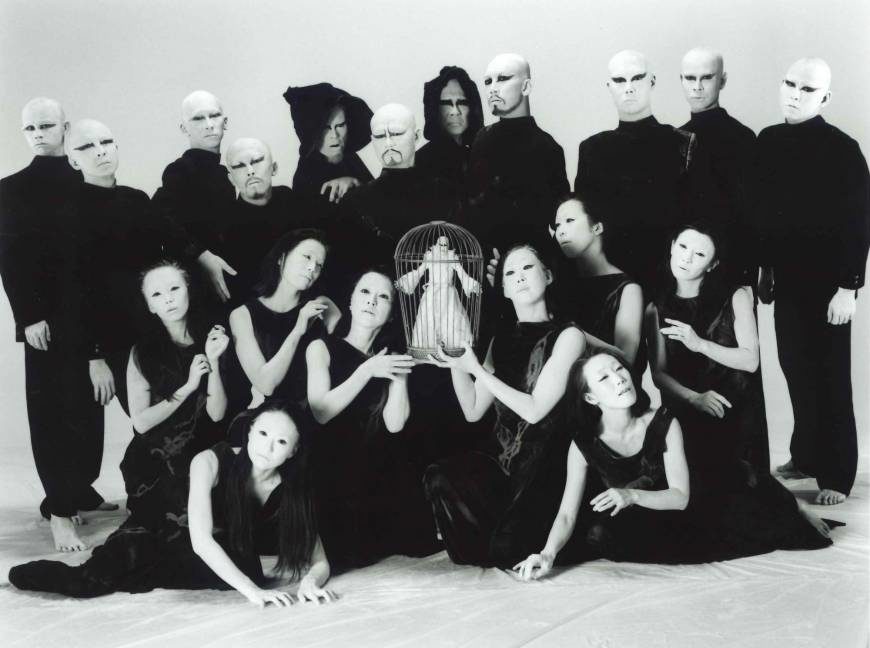
Dostoyevsky dance Butoh troupe Dairakudakan is set to perform its take on the Russian classic Crime And Punishment at the New National Theatre, Tokyo. Photo: Nobuyoshi Araki
Although butoh may appear eerily timeless, it only dates from 1959. That was when Maro’s former mentor, Tatsumi Hijikata (1928-86), introduced it to the world with the premiere of Kinjiki (Forbidden Colors), his two-person work with Yoshito Ohno that was inspired by Yukio Mishima’s eponymous 1951 novel whose Japanese title is a euphemism for homosexuality.
The expressionist genre’s popularity got a big boost when its groundbreaking spirit—especially in contrast to formalized Western forms such as ballet or even modern dance—gelled with counterculture movements that were reshaping the world in the 1960s and ’70s.
Since then, butoh has steadily risen to become a foremost form of original Japanese theater, and Maro has done a lot to put it on the international map through Dairakudakan’s many overseas shows—specifically in France, but also in Italy, Germany, the United States, Canada, Australia, Mexico, and Brazil.
Unlike many butoh artists who work alone or in intimate troupes, Maro—who founded Dairakudakan in 1972—has also trained a stream of top young dancers, many of whom have gone on to form their own companies.
Yet paradoxically, butoh still doesn’t have a very high profile in Japan, and even though dance became a compulsory school activity in 2012, the numbers engaging with butoh remain few compared with those involved in ballet and other forms of dance.
As a result, Crime and Punishment, which is being staged at the NNTT’s Playhouse with its 1,000-plus seats, is a great chance for Japanese and non-Japanese alike to experience the power and beauty of this somewhat hidden cultural gem.
The NNTT rehearsal room where Dairakudakan’s members have gathered to practice is bright and airy, with its mirror wall and barrels lining the side, but the atmosphere is a stark contrast to the tone of the subject matter they’ll be performing.
Maro and his 19-strong cast of male and female dancers must delve deep into the human psyche in order to voicelessly convey the tortured spirit of a young murderer that Russian writer Fyodor Dostoyevsky first brought to life in 1866. The maestro seems undaunted by the challenge.
I simply hope that the people who usually attend the NNTT, for opera and ballet, will come to see our entirely different approach to dance, he says.
Maro explains how he plans to take advantage of the Playhouse’s large rotating stage in order to change sets and create a grand vision of Dostoyevsky’s universe.
“Through my own works,- he continues, – I constantly question the meaning of the words ‘aesthetic,’ ‘death,’ and ‘art,’ but this time I’m hugely inspired by Dostoyevsky’s novel, which I first read in my youth, and how it examines the way young people find their position in society and what constitutes genuine atonement for a wrong.
After all, a legal sentence is just the workings of a social system, whereas I think it may be near impossible for a person to find atonement within themselves. But society is now so complicated, and many of today’s crimes are so twisted and fuzzy, that I’m exploring nihilistic uncertainty here, too.
As the dancers finish limbering up they separate into two groups with different colored costumes. Are they “crime” and “punishment?” Are they “falsehood” and “truth?” Regardless, it’s mesmerizing to watch as they express grief, anger, and fear by twisting their limbs and contorting their faces. In the background, the solemn notes of Russian composer Modest Mussorgsky’s Night On Bald Mountain fill the room. It is one of 10 classical pieces Maro will use in the performance.
Afterward, the director explains that he gives each dancer a certain level of freedom to develop their own gestures, though he sometimes makes adjustments—cryptically, in staccato dicta such as, “Too much!” or “Too fussy!”
I think ballet dancers ignore a lot of what their bodies are able to do in order to achieve the ideal posture or a perfectly picturesque form, – Maro says, explaining how his art form differs from other kinds of dance. – In butoh, we take advantage of what they ignore and find new worth in what they might consider rubbish.
Butoh performers also draw on those forgotten body movements and behaviors that have existed throughout humanity’s 200,000-year history.
Then, with his characteristic and disarming modesty, this imposing figure of a man adds, almost chuckling,
That’s my idea of butoh anyway, but each artist has their own theory of what it is because nothing is fixed or definite. Basically, any performer can be a butoh sect of their own.
How could someone start their own sect, though? Observing the way these people move is at once exhausting and a bit unnerving. Surely there must be a textbook or some kind of YouTube instruction video to get you started?
Maro explains that Dairakudakan offers a week-long workshop—open to everyone regardless of linguistic ability—every summer in Hakuba, a mountainous area of Nagano Prefecture. In the end, everyone takes part in a public performance in which they appear with their bodies covered in gold-colored powder.
At the start of the course, Maro says he typically asks participants to brainstorm various gestures while he teaches them some basic butoh movements.
People who are new to butoh get confused, – he says. – If there was a certain method, you could just follow and practice it. But in butoh we reject that sort of theory so we ask questions in order to learn, like, ‘Why are you standing here? Why do you walk like that—and who decided you should do it that way?’ It’s important not to blindly follow someone else’s instructions, you need to discover your own path.
Maro says that, given this kind of freedom, beginners will often clam up in confusion —but that’s not a bad thing.
I think that this body shape, frozen in motion, is an interesting base for performing butoh,” he says. “We call it the ‘human mold’ and it has a strong tension to it that relates to the inner mind.
Gesturing back at the dancers, Maro adds that the concepts at the heart of this form of dance are very Japanese.
In butoh we imagine we are empty, like a bowl or mold with nothing in it. It is then the things around us—the air, objects, circumstances, other people or whatever—that govern our actions.
Because of the self-assertion inherent in Western culture, everything begins with ‘I.’ In butoh, we forget about that ‘I’ and entrust our bodies to external influences.
Having said that, Maro reasserts that he doesn’t think butoh is only for the Japanese.
I think back to ancient times when there were no borders or nationalities,- he says. – It’s there that I can find those aspects of humanity we may all have dropped along the way.
Crime and Punishment was performed on March 17 and 18 at the New National Theatre, Tokyo’s Playhouse (2 p.m. start). For details, visit www.dairakudakan.com.
This article originally appeared in Japan Times on March 15, 2018, and has been reposted with permission.
This post was written by the author in their personal capacity.The opinions expressed in this article are the author’s own and do not reflect the view of The Theatre Times, their staff or collaborators.
This post was written by Nobuko Tanaka.
The views expressed here belong to the author and do not necessarily reflect our views and opinions.

